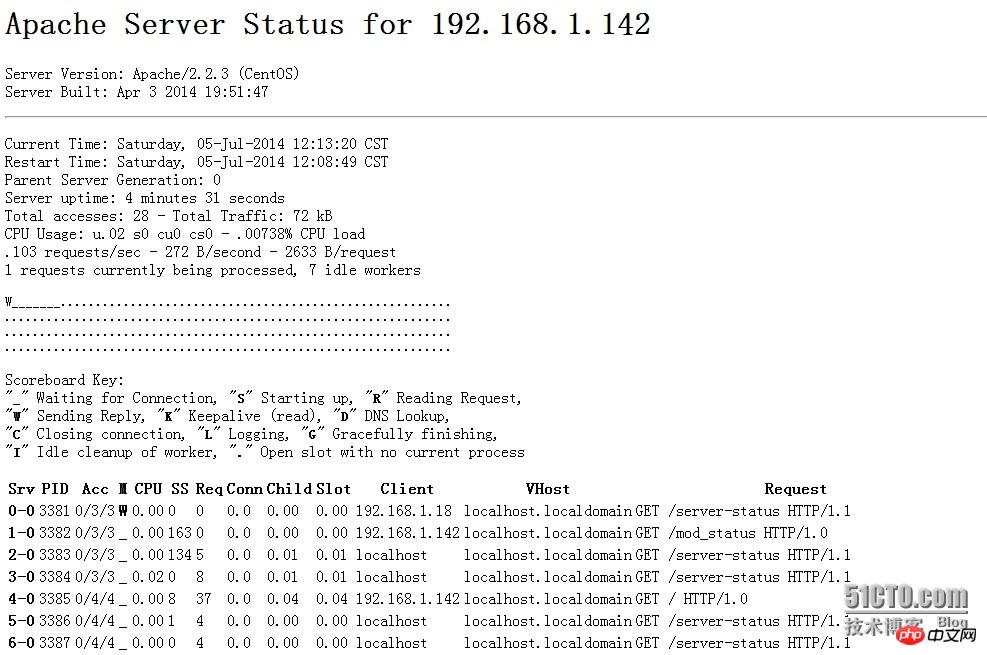 Backend Development
Backend Development
 PHP Tutorial
PHP Tutorial
 Detailed explanation of using mod_status module to monitor apache service instances
Detailed explanation of using mod_status module to monitor apache service instances
Detailed explanation of using mod_status module to monitor apache service instances


##Parameter description:
字段 说明 Server Version Apache 服务器的版本。 Server Built Apache 服务器编译安装的时间。 Current Time 目前的系统时间。 Restart Time Apache 重新启动的时间。 Parent Server Generation Apache 父程序 (parent process) 的世代编号,就是 httpd 接收到 SIGHUP 而重新启动的次数。 Server uptime Apache 启动后到现在经过的时间。 Total accesses 到目前为此 Apache 接收的联机数量及传输的数据量。 CPU Usage 目前 CPU 的使用情形。 _SWSS.... 所有 Apache process 目前的状态。每一个字符表示一个程序,最多可以显示 256 个程序的状态。 Scoreboard Key 上述状态的说明。以下为每一个字符符号所表示的意义: * _:等待连结中。 * S:启动中。 * R:正在读取要求。 * W:正在送出回应。 * K:处于保持联机的状态。 * D:正在查找DNS。 * C:正在关闭连结。 * L:正在写入记录文件。 * G:进入正常结束程序中。 * I:处理闲置。 * .:尚无此程序。 Srv 本程序与其父程序的世代编号。 PID 本程序的process id。 Acc 分别表示本次联机、本程序所处理的存取次数。 M 该程序目前的状态。 CPU 该程序所耗用的CPU资源。 SS 距离上次处理要求的时间。 Req 最后一次处理要求所耗费的时间,以千分之一秒为单位。 Conn 本次联机所传送的数据量。 Child 由该子程序所传送的数据量。 Slot 由该 Slot 所传送的数据量。 Client 客户端的地址。 VHost 属于哪一个虚拟主机或本主机的IP。 Request 联机所提出的要求信息。
This article comes from the "Operation and Maintenance Work Notes" blog, please be sure to keep this source and use the mod_status module to monitor the apache service
The above is the detailed content of Detailed explanation of using mod_status module to monitor apache service instances. For more information, please follow other related articles on the PHP Chinese website!

Hot AI Tools

Undresser.AI Undress
AI-powered app for creating realistic nude photos

AI Clothes Remover
Online AI tool for removing clothes from photos.

Undress AI Tool
Undress images for free

Clothoff.io
AI clothes remover

Video Face Swap
Swap faces in any video effortlessly with our completely free AI face swap tool!

Hot Article

Hot Tools

Notepad++7.3.1
Easy-to-use and free code editor

SublimeText3 Chinese version
Chinese version, very easy to use

Zend Studio 13.0.1
Powerful PHP integrated development environment

Dreamweaver CS6
Visual web development tools

SublimeText3 Mac version
God-level code editing software (SublimeText3)

Hot Topics
 1652
1652
 14
14
 1413
1413
 52
52
 1304
1304
 25
25
 1251
1251
 29
29
 1224
1224
 24
24
 How to set the cgi directory in apache
Apr 13, 2025 pm 01:18 PM
How to set the cgi directory in apache
Apr 13, 2025 pm 01:18 PM
To set up a CGI directory in Apache, you need to perform the following steps: Create a CGI directory such as "cgi-bin", and grant Apache write permissions. Add the "ScriptAlias" directive block in the Apache configuration file to map the CGI directory to the "/cgi-bin" URL. Restart Apache.
 How to connect to the database of apache
Apr 13, 2025 pm 01:03 PM
How to connect to the database of apache
Apr 13, 2025 pm 01:03 PM
Apache connects to a database requires the following steps: Install the database driver. Configure the web.xml file to create a connection pool. Create a JDBC data source and specify the connection settings. Use the JDBC API to access the database from Java code, including getting connections, creating statements, binding parameters, executing queries or updates, and processing results.
 How to view your apache version
Apr 13, 2025 pm 01:15 PM
How to view your apache version
Apr 13, 2025 pm 01:15 PM
There are 3 ways to view the version on the Apache server: via the command line (apachectl -v or apache2ctl -v), check the server status page (http://<server IP or domain name>/server-status), or view the Apache configuration file (ServerVersion: Apache/<version number>).
 What to do if the apache80 port is occupied
Apr 13, 2025 pm 01:24 PM
What to do if the apache80 port is occupied
Apr 13, 2025 pm 01:24 PM
When the Apache 80 port is occupied, the solution is as follows: find out the process that occupies the port and close it. Check the firewall settings to make sure Apache is not blocked. If the above method does not work, please reconfigure Apache to use a different port. Restart the Apache service.
 How to view the apache version
Apr 13, 2025 pm 01:00 PM
How to view the apache version
Apr 13, 2025 pm 01:00 PM
How to view the Apache version? Start the Apache server: Use sudo service apache2 start to start the server. View version number: Use one of the following methods to view version: Command line: Run the apache2 -v command. Server Status Page: Access the default port of the Apache server (usually 80) in a web browser, and the version information is displayed at the bottom of the page.
 How to solve the problem that apache cannot be started
Apr 13, 2025 pm 01:21 PM
How to solve the problem that apache cannot be started
Apr 13, 2025 pm 01:21 PM
Apache cannot start because the following reasons may be: Configuration file syntax error. Conflict with other application ports. Permissions issue. Out of memory. Process deadlock. Daemon failure. SELinux permissions issues. Firewall problem. Software conflict.
 How to configure zend for apache
Apr 13, 2025 pm 12:57 PM
How to configure zend for apache
Apr 13, 2025 pm 12:57 PM
How to configure Zend in Apache? The steps to configure Zend Framework in an Apache Web Server are as follows: Install Zend Framework and extract it into the Web Server directory. Create a .htaccess file. Create the Zend application directory and add the index.php file. Configure the Zend application (application.ini). Restart the Apache Web server.
 How to delete more than server names of apache
Apr 13, 2025 pm 01:09 PM
How to delete more than server names of apache
Apr 13, 2025 pm 01:09 PM
To delete an extra ServerName directive from Apache, you can take the following steps: Identify and delete the extra ServerName directive. Restart Apache to make the changes take effect. Check the configuration file to verify changes. Test the server to make sure the problem is resolved.



